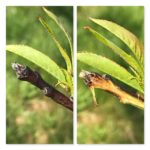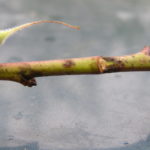Evaluating Freeze Damage in Tree Fruit: The subfreezing temperatures on the morning of April 17 Caused injury at varying levels across the state. Lows ranged from 27-30 in southern counties. Much is the damage is now visible. Any physiological damage that is not visible now will appear as the season progresses. A helpful guide for evaluating fruit damage can be in the Intermountain Tree Fruit Production Guide.
Tree Fruit Phenology: Tree Fruit Phenology remains advanced, but development is slowing. In southern counties all peach orchards are late bloom to early Shuck Split. Redhaven was at approximately full bloom on March 30, and was at Petal Fall by April 14. Peach bloom has been very long this year. Plums are past shuck fall. Pears are late bloom/Petal Fall. Red Delicious is pink to 50% bloom. Cherries are at 50% bloom.
Peach:
Brown Rot: Blossom infections from the brown rot fungus can occur whenever pistils are exposed and a favorable climate exists. Infections can occur during any wetting period when temperatures are between 41 and 86 °F. However, optimum conditions for infection occur with wetting and temperatures in the mid 70’s. During long wetting periods (several days or more) blossoms can be infected regardless of temperature. Generally infections that occur when conditions are sub optimal are less severe. Blossoms and fruitlets will remain susceptible until the pistil dessicates (sometime between petal fall and shuck split). Initiate coverage for blossom blight starting at pink for short petaled varieties and 5-10% bloom for showy flowers. Blossom blight sprays are largely over in southern counties. See the NJ Commercial Tree Fruit Production Guide for recommended materials and rates.
Bacterial Spot: Copper formulations should be used starting now to suppress bacterial spot. Generally we recommend starting at 0.5 ozs metallic copper and gradually lowering the rate as the season progresses. The rate applied will depend on the formulation. Dr. Lalancette published a chart listing common copper formulations and rates for peach and nectarine applications. Avoid combining copper with captan especially if it has been overcast for several days. Also avoid acidic spray solutions when applying copper. Dr. Lalancette has published a handy guide for copper applications in early covers. Antibiotics such as mycoshield or fireline may also be used and offer slightly more residual activity during long wetting periods. Black tip cankers began appearing last week (Fig.1)
Peach Scab: In addition to Rusty Spot and Bacterial Spot, Peach Scab requires protective applications starting at petal fall. Peach scab cankers (Fig. 2) begin to expand at bloom and by shuck split begin to shed spores during wetting periods. Topsin, Topsin/Captan combinations, Flint Extra, Inspire Super, and especially Quadris Top applied at petal fall are the best materials for blocks that had scab last year. Quadris Top, Flint Extra or Topsin should be used at the high rate to suppress overwintering lesions on the wood. Quadris Top contains azoxystrobin which is phytotoxic to many apple varieties. Phytotoxic residues can remain in the tank for long periods after an application is made, even if a tank cleaner is used. Do not use Quadris Top or Abound in the same sprayer used for apples. Bravo (chlorothalonil) is also a good protectant that may be applied no later than shuck split. Captan is also helpful in cover sprays after shuck split where scab was troublesome last year.
Oriental Fruit Moth: The first OFM adults were caught on 3/30 in Gloucester county. A biofix point for OFM was set on 4/3 in southern counties. The first insecticides for first generation Oriental Fruit Moth control should be applied at 170-200 degree days base 45 after biofix. This timing generally coincides with petal fall in peaches. Currently we have accumulated 108 Degree days from the biofix. The timing for the first insecticides for OFM will be on or about 4/28-5/1 in southern counties. In Northern Counties a biofix was set on 4/9 and 38 degree days have accumulated. Predictions for insecticide timings in northern counties are too far out.
Green Peach Aphid: GPA colonies begin forming sometime during bloom. Examine trees for the presence of colonies from pink to shuck split. Count the number of colonies on ten trees and use a treatment threshold of 2 colonies/tree at petal fall for peach, and 1 colony/tree for nectarine. The best way to scout for aphids during bloom is with a beating tray. Blossoms may also be collected, opened, and examined for the presence of aphids using a hand lens. This is particularly important for nectarine blocks. Check 10 trees per block with the beating tray. Collect 50 blossoms per block and examine for the presence of aphids. If more than 1 colony of aphids are found in nectarines, or 2-3 colonies are found in peaches, an insecticide for aphids will be needed when all petals are off. See the NJ Commercial Tree Fruit Production Guide for recommended materials and rates. No aphid activity has been noted on southern counties to date.
Plum Curculio; Tarnished Plant Bugs; and Other Catfacing Insects: Catfacing insects are starting activity but cause little damage at this time of the year. Catfacing insects will become more of an issue as temperatures warm and mowing and other ground cover activities become more common after bloom. Insecticides for catfacing insects are not recommended until after all petals are off. Plum Curculio start to move into orchards after a few days above 70 deg F. Adults feed on developing fruit before beginning oviposition activity: usually after Shuck split. No insecticides are needed for plum curculio or plant bugs at this time.
Apples and Pears:
Diseases: Apple Scab and Rust Diseases are the main targets at this stage. The NEWA scab models are estimating about 84% ascospore maturity as of 4/20 in southern NJ with 69% of cumulative ascospores discharged. We are past peak ascopore discharge in southern counties. Northern counties will have less ascospore maturity. Primary apple scab spores are released during any substantial infection period. Between tight cluster and first cover include products effective for powdery mildew and cedar apple rust. More information can be found in this blogpost from Penn State. For both apples and pears, consider using Kasumin at bloom. Kasumin is an antibiotic like Streptomycin and Oxytetratracycline. It contains Kasugamycin which is a different chemistry. Kasumin is only labeled for bloom and petal fall applications while strep and oxytet are labeled for post bloom use. Using 3 different chemistries in rotation allows for resistance management while extending the protection into the post bloom period when late blossoms typically appear. which ever material you use, the addition of Actigard or other plant defense elicitors may improve control.
Rust Diseases: The two most common rust diseases that affect pome fruit are Quince Rust and Cedar Apple Rust. In some years these diseases can be troublesome in commercial orchards. Most disease control programs for scab will also control rust. In organically managed blocks in the east options are limited for approved materials that are effective for rust. Potassium Bicarbonate products have shown good efficacy for rust diseases in trials performed in Virginia. Organic growers should seek out and plant rust resistant cultivars. Cultural controls are not practicable due to the widespread presence of alternate host Junipers both wild and cultivated. Rust disease development on junipers should now be producing large spore releases during wetting periods. See this link for pictures of rust on pome fruit and juniper.
Rosy Apple Aphid: If a pre-bloom application was not made, monitor for colonies during bloom and use a treatment threshold of 1 colony/tree at petal fall.
Pear Psylla: Dormant oil applications should have already been started to deter psylla egg laying. At the green cluster stage a pyrethroid is generally included with oil to knock down adults migrating into the orchard. In lieu of oil, Surround may also be applied starting at swollen bud and continued through bloom. If using Esteem for psylla control make one application delayed dormant through popcorn or two applications; one at delayed dormant through popcorn and one at petal fall. Centaur is also effective and one application may be made pre-bloom or at petal fall. Sivanto Prime is also labeled for early season applications and should be combined with oil. See this 2020 blogpost from Peter Jentsch at Cornell for a more detailed control discussion.
Pear Diseases: Include effective materials such as Ziram or EBDC formulations for Pear Scab and Rust diseases beginning at the cluster bud stage. At white bud use products effective for pear scab, rusts, and fabrea leaf spot. For both apples and pears, consider using Kasumin at bloom. Kasumin is an antibiotic like Streptomycin and Oxytetratracycline. It contains Kasugamycin which is a different chemistry. Kasumin is only labeled for bloom and petal fall applications while strep and oxytet are labeled for post bloom use. Using 3 different chemistries in rotation allows for resistance management while extending the protection into the post bloom period when late blossoms typically appear. which ever material you use, the addition of Actigard or other plant defense elicitors may improve control.



